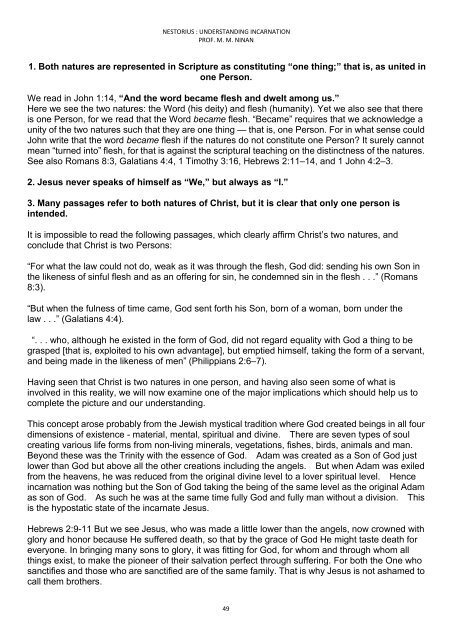Nestorius
You also want an ePaper? Increase the reach of your titles
YUMPU automatically turns print PDFs into web optimized ePapers that Google loves.
NESTORIUS : UNDERSTANDING INCARNATION<br />
PROF. M. M. NINAN<br />
1. Both natures are represented in Scripture as constituting “one thing;” that is, as united in<br />
one Person.<br />
We read in John 1:14, “And the word became flesh and dwelt among us.”<br />
Here we see the two natures: the Word (his deity) and flesh (humanity). Yet we also see that there<br />
is one Person, for we read that the Word became flesh. “Became” requires that we acknowledge a<br />
unity of the two natures such that they are one thing — that is, one Person. For in what sense could<br />
John write that the word became flesh if the natures do not constitute one Person? It surely cannot<br />
mean “turned into” flesh, for that is against the scriptural teaching on the distinctness of the natures.<br />
See also Romans 8:3, Galatians 4:4, 1 Timothy 3:16, Hebrews 2:11–14, and 1 John 4:2–3.<br />
2. Jesus never speaks of himself as “We,” but always as “I.”<br />
3. Many passages refer to both natures of Christ, but it is clear that only one person is<br />
intended.<br />
It is impossible to read the following passages, which clearly affirm Christ’s two natures, and<br />
conclude that Christ is two Persons:<br />
“For what the law could not do, weak as it was through the flesh, God did: sending his own Son in<br />
the likeness of sinful flesh and as an offering for sin, he condemned sin in the flesh . . .” (Romans<br />
8:3).<br />
“But when the fulness of time came, God sent forth his Son, born of a woman, born under the<br />
law . . .” (Galatians 4:4).<br />
“. . . who, although he existed in the form of God, did not regard equality with God a thing to be<br />
grasped [that is, exploited to his own advantage], but emptied himself, taking the form of a servant,<br />
and being made in the likeness of men” (Philippians 2:6–7).<br />
Having seen that Christ is two natures in one person, and having also seen some of what is<br />
involved in this reality, we will now examine one of the major implications which should help us to<br />
complete the picture and our understanding.<br />
This concept arose probably from the Jewish mystical tradition where God created beings in all four<br />
dimensions of existence - material, mental, spiritual and divine. There are seven types of soul<br />
creating various life forms from non-living minerals, vegetations, fishes, birds, animals and man.<br />
Beyond these was the Trinity with the essence of God. Adam was created as a Son of God just<br />
lower than God but above all the other creations including the angels. But when Adam was exiled<br />
from the heavens, he was reduced from the original divine level to a lover spiritual level. Hence<br />
incarnation was nothing but the Son of God taking the being of the same level as the original Adam<br />
as son of God. As such he was at the same time fully God and fully man without a division. This<br />
is the hypostatic state of the incarnate Jesus.<br />
Hebrews 2:9-11 But we see Jesus, who was made a little lower than the angels, now crowned with<br />
glory and honor because He suffered death, so that by the grace of God He might taste death for<br />
everyone. In bringing many sons to glory, it was fitting for God, for whom and through whom all<br />
things exist, to make the pioneer of their salvation perfect through suffering. For both the One who<br />
sanctifies and those who are sanctified are of the same family. That is why Jesus is not ashamed to<br />
call them brothers.<br />
49

















